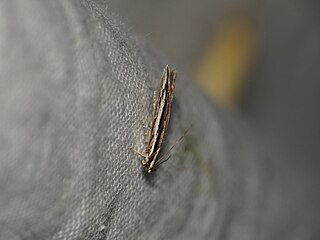| Apiletria tripleura | |
|---|---|
| Scientific classification | |
| Kingdom: | Animalia |
| Phylum: | Euarthropoda |
| Class: | Insecta |
| Order: | Lepidoptera |
| Family: | Autostichidae |
| Genus: | Apiletria |
| Species: | A. tripleura |
| Binomial name | |
| Apiletria tripleura (Meyrick, 1914) | |
| Synonyms | |
| |
Apiletria tripleura is a moth in the family Autostichidae. It was described by Meyrick in 1914. It is found in the western Himalayas. [1]

Moths comprise a group of insects related to butterflies, belonging to the order Lepidoptera. Most lepidopterans are moths, and there are thought to be approximately 160,000 species of moth, many of which have yet to be described. Most species of moth are nocturnal, but there are also crepuscular and diurnal species.
Autostichidae is a family of moths in the moth superfamily Gelechioidea.
Edward Meyrick FRS was an English schoolmaster and amateur entomologist. He was an expert on Microlepidoptera and some consider him one of the founders of modern Microlepidoptera systematics.
The wingspan is about 18 mm. The forewings are grey suffusedly mixed with light ochreous-yellowish, and towards the apex mixed with white. There is a narrow white costal streak from the base to near the apex and a white streak in the disc from one-fourth to the termen, attenuated to a point anteriorly, becoming bifurcate posteriorly. There is also a white streak along the submedian fold from the base to the torus. The hindwings are grey. [2]

The wingspan of a bird or an airplane is the distance from one wingtip to the other wingtip. For example, the Boeing 777-200 has a wingspan of 60.93 metres, and a wandering albatross caught in 1965 had a wingspan of 3.63 metres, the official record for a living bird. The term wingspan, more technically extent, is also used for other winged animals such as pterosaurs, bats, insects, etc., and other fixed-wing aircraft such as ornithopters. In humans, the term wingspan also refers to the arm span, which is distance between the length from one end of an individual's arms to the other when raised parallel to the ground at shoulder height at a 90º angle. Former professional basketball player Manute Bol stands at 7 ft 7 in (2.31 m) and owns one of the largest wingspans at 8 ft 6 in (2.59 m).

